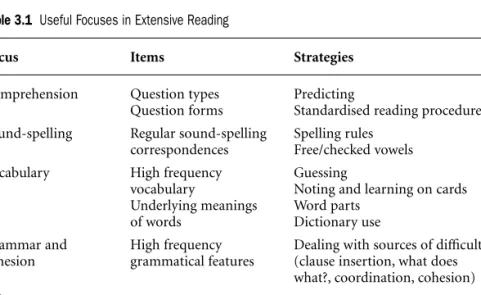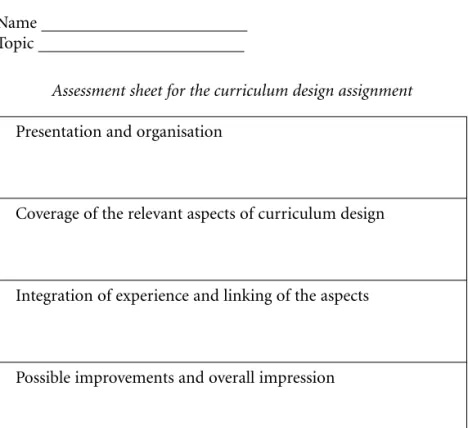First, it has a strong practical emphasis—about a hundred teaching techniques are described in the book. There are many people to thank for their help in producing this book.
Learning to Read in Another Language 1
So before the student actually starts reading the story, the ideas and important words in the story are discussed and clarified. There are many factors that affect the difficulty of learning to read in a second language.
Learning to Recognise and Spell Words 2
It is awareness of the general principle that words are made up of separable sounds. Students look at a word, close their eyes and try to see the spelling of the word in their mind.

Intensive Reading 3
There are four different types of sentence completion. i) The sentences are exact copies of the sentences in the passage. ii). Students find these words in the passage and write the subjects and objects (if any) of the words according to the passage.

Extensive Reading 4
At the back of each book there can be a piece of paper on which students can write down their opinion about the book. One of the most useful ways the course can support extensive reading is by providing training in faster reading. This is because the vocabulary from the earlier levels is very common in the books at the later levels.
Thus, the books of the later levels provide good conditions for learning the entire vocabulary of the graded reader series. This number of graded readers provides a lot of repetition for the vocabulary and provides the opportunity to encounter most of the vocabulary several times. Students should progress through graded reader levels as the later levels provide excellent conditions for building the vocabulary of the earlier levels.
These criticisms are mostly true of readers rated at lower quality, but there are many of high quality (Day and Bamford, 1998). Here are some of the 3,038 words that occur only once in the original Dracula - care, therapy, physiognomy, ordinary, lush.

Reading Faster 5
If someone reads at a rate of 400 words per minute or more, that person is no longer focusing on most of the words in the text. Reading speed is influenced by a number of factors, including the purpose of reading and the difficulty of the text. The difficulty of the text is influenced by vocabulary, grammatical constructions, discourse and background knowledge.
With practice, a fluency in recognizing the different letters develops and soon the basic unit with which the reader works no longer consists of the parts of the letters, but of the letters themselves. What this means is that developing fluency doesn't just mean getting faster, it also involves changing the size and nature of the basic unit the reader is working with. One could call this “the well-trodden path” and the 4/3/2 activity is an example of this.
A paired reading activity can take about 15 to 30 minutes, and the learners must be trained in the use of the procedure. Multiple choice questions or true/false questions that focus on the gist of the text can also be used.
Assessing Reading 6
If the answers the learners have to make are short, more questions can be answered and thus increase the reliability and validity of the test. Since factors other than vocabulary knowledge are involved in the test, this affects the validity of the test. Just under 50 percent of the words in a fixed deletion cloze test are likely to be function words.
This means that the format of the test should be familiar to the students and the instructions should be clear. Scoring the transfer of information portion of the test will include decisions that may affect the consistency of scoring. Have someone able to translate the questions into the students' first language to see if they make the same sense when translated.
To check if the questions read the text, ask a very skilled reader, perhaps a native speaker, to answer the questions without reading the text. Usually, the order of the questions should be in the same order as the information in the text.

Helping Learners Write 7
Since the learners cannot remember all the words of the story, they have to make up parts of it themselves. Marking is usually easy because the learners correct most of the mistakes themselves before handing the composition to the teacher. It is easier for the learners if the teacher gives them an example of the sentence pattern.
By answering the questions with the help of the picture, students can write a composition. Word order gives students sentences with the words in the wrong order. The teacher shows the students how to change the sentences to talk about different things.
Can the teacher bring the language, ideas, necessary writing skills, or text organization into the students' experience. Can the possible organization of the text be outlined and explained to students.
The Writing Process 8
An important part of the writing process is looking back on what has been written. As with all other parts of the writing process, editing does not happen at a fixed point in the process. One way is to base the feedback on the parts of the writing process described above.
Poor performance in this part of the process is signaled by the lack of a cohesive purpose. Poor performance in this part of the process is the result of not having enough to say. Does the range of ideas provide adequate full coverage of the subject areas?
Poor performance in this part of the process is signaled by a short piece of text, poorly worded sentences, a. Poor performance in this part of the process is signaled by poorly organized and poorly presented text.

Topic Types 9
The topic type hypothesis states that texts on different topics, but all of the same topic type, will contain the same general types of information. Is there anything that needs special attention at any of the steps. They can then list the questions for each part of the topic type and suggest answers to those questions that are closely related to the topic of the text.
If the students are not familiar with the topic types, the teacher shows the students the relevant topic type and then gives them general questions for each part of the topic type. Here is an example based on a text called Limestone Caves, an example of the process theme type. If the learner wants to take detailed notes, it may be worth completing an information transfer diagram based on the parts of the topic type (see Nation and Newton, 2009 for more discussion on information transfer).
In this case, checking the text against the theme type parts can reveal what is missing and help decide if the missing parts should really be there. The way to test for this is the question "What should students know after reading this text?".

Responding to Written Work 10
In Chapter 8, we looked at ways to provide feedback on various parts of the writing process. The use of self-assessment promotes metacognitive awareness of the writing process and the qualities of good writing. Feedback can be uncontrolled if verbal or written comments are made about the strengths and weaknesses of the written work without systematic coverage of the scale.
Each part of the scale can be accompanied by a short comment explaining why that point on the scale was chosen. This improvement can be in the amount of writing, the quality of the writing and the quality and range of the content. Part of the writing process is to check what has been written to make improvements.
Comment: by turning on the Comment function in the Insert menu, the teacher can add useful suggestions for improving the text or praise parts of the text. It is also possible to focus fairly large parts of the course on one or two strands.

Points of Correspondence
In the list of 1000 words there are other points of correspondence, which are so rare that they are not included in any of these lists. These three lists are also divided into vowel features and consonant features, and then each point of correspondence is listed alphabetically and numbered accordingly. Letters that are not underlined are environmental features of the correspondence and do not participate in the correspondence, khs.
The phonemic transcription is from the Oxford Advanced Learner's Dictionary of Current English (revised 3rd edition). Divide each of the following words into parts and mark the spelling rule that applies to each part. Sort the following words into three groups according to the correct spelling.
In the following lists, American pronunciations are noted in a separate column where they differ significantly from British pronunciations. Length marks are used in US transcriptions, although this is not always common practice in the US. in grammatical and lexical words, F. in ordinary lexical and grammatical words.
Relationships
Tracking the unique effects of print exposure in children: Associations with vocabulary, general knowledge, and spelling. Phonemic awareness instruction helps children learn to read: Evidence from the National Reading Panel meta-analysis. Text as a vehicle for information: The use of written texts in the classroom in teaching reading as a foreign language.
Effects of input elaboration on vocabulary acquisition through Korean learners' reading of English as a foreign language. The effects of ESL-trained content area teachers: Reducing high school students to incidental language learners. Pedagogical alternatives to “explication de texte” as a procedure for teaching reading comprehension, with special attention to EST.
The effects of pre-provision of context on the oral reading skills of a low-progress reader.